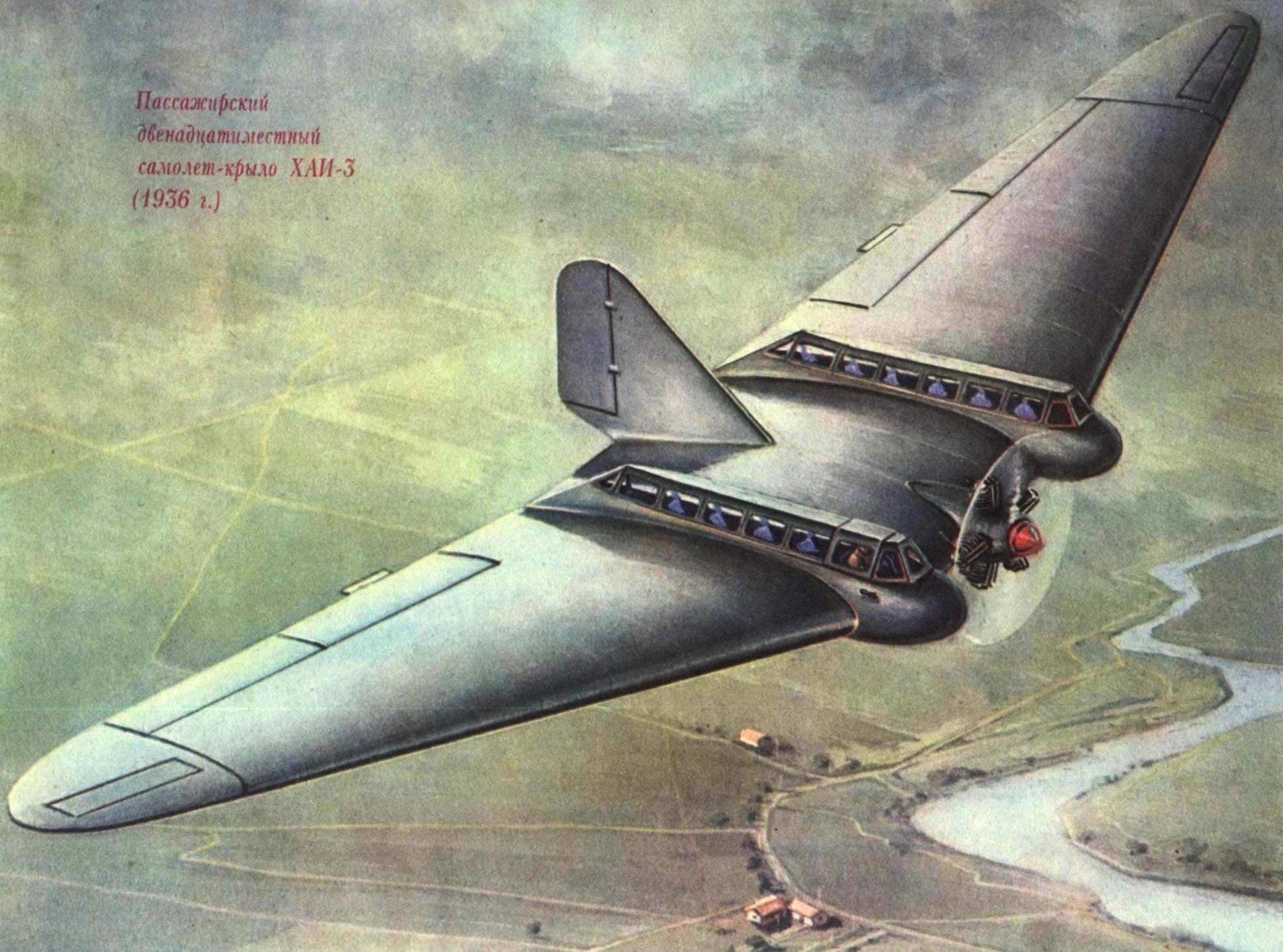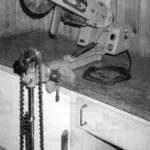 In the late 30-ies of work on tailless aircraft has reached such a level that the aircraft could proceed to the creation of transport aircraft wings. To new, unusual striving youth, and there is nothing surprising in the fact that students of the Kharkiv aviation Institute in 1935 for the first time in the world engaged in the design of a 12-seater passenger aircraft “slipped wing”. For the project used the idea of “planetaleto”, that is, low-speed aircraft with good aerodynamics.
In the late 30-ies of work on tailless aircraft has reached such a level that the aircraft could proceed to the creation of transport aircraft wings. To new, unusual striving youth, and there is nothing surprising in the fact that students of the Kharkiv aviation Institute in 1935 for the first time in the world engaged in the design of a 12-seater passenger aircraft “slipped wing”. For the project used the idea of “planetaleto”, that is, low-speed aircraft with good aerodynamics.
“Planneralm” is, essentially, a giant glider. At that time it was believed that an aircraft of such a scheme, consuming little fuel and undemanding to conditions of take-off and landing will be able to provide mass air transportation. That is why the Civil air fleet of our country gave the order to the designers to create planetaleto to transport one ton of cargo or ten passengers at an average speed of 120 km/h.
After a long calculation estimation and trial layouts young designers planetaleto HAI-3 stayed in the original scheme. On the wing with a sweep of about 20° and extension of 6.5 and a straight trailing edge they are closed dvuhfyuzelyazhny compartment (each compartment — for 6 people). Engine with a tractor propeller was placed between the fuselages. In the front right of the cockpit housed the pilot.
Testing began in mid-September 1936 in Kharkov. Spent their famous pilot of the CAF, before the glider pilot V. Borodin. First circling flight took place on 23 September 1936.
Then followed extensive flight tests with a flight weight of from 1,750 to 2 thousand kg, which confirmed good stability and controllability of the apparatus.
The landing and turns to HAI-3 because of the original control system was a bit unusual. However, after the pilot was familiar with the plane, pilot it has become quite easy. During flight tests on the HAI-3 was even made a record jump from a height of 80 m a parachutist-athlete B. young Kosula method of failure with the rear edge of the wing. After factory flight test pilot V. Borodin, along with lead engineer M. Samoilov made a flight without landing from Kharkov to Tambov. The flight was successful, despite the very bad weather the plane got into a storm cloud.

HAI-3: year built — 1936, a wingspan of 22.4 m; gross weight — 2200 kg; the motor M-11 — 110 HP maximum speed — 130 km/h, landing speed 60 km/h.

Steering control scheme.

“HORTEN V”: year of construction — 1940, a wingspan of 16 m, length 6.5 m, wing area — 42 m2, empty weight — 650 kg, flying weight — 1100 kg, engines — 2 “Hirt НМ60” for 80 HP each, the highest design speed of 260 km/h, landing speed 75 km/h.
And now more about the plane. The wing consisted of three parts: a metal center section, welded from chrome-molybdenum steel tubing, and two detachable wooden consoles. The wing profile is V-shaped In-106 with the relative thickness of the center section 14%, and at the end of the wing — 7%. The center section consisted of four spars and six ribs and had a metal casing made of aluminum with a thickness of 0.5 mm. betoniarnia Console, they are the main element of the caisson, plywood tapered tube, the wall thickness of which was changed along the span of the wing. Inside were two plywood walls which gave the wing bending strength. Outside the caisson was reinforced with a large number of stringers. It took about half the width of the wing and took all the loads. (Such design in those days was very progressive, and subsequently it is often used in aircraft.) Ribs cantilever part of the wing had a frame structure. End ribs was given a negative twist of 8° relative to the center section.
On consoles housed the ailerons, each of which the wing span was divided into two parts. Longitudinal control of the aircraft was carried out by moving the control column forward and backward. Both Aileron (now they are called elevons) at the same time as the elevators were deflected trailing edge down when the pilot gave helm myself, and upward — in the position itself. When rotating the same wheel to the left or right provided lateral control. To adjust the plane in the longitudinal direction ends of the wing HAI-3 turns a special wheel mounted on the left side of the cockpit.
Resistance was provided at HAI-3 keel, located on the rear part of the wing in the jet propeller. On the tail was the rudder. In addition, to control the rate of served double-flaps — spoilers. They acted like this: at the same time progress forward pedal, the spacecraft which pushed the foot pilot, deflected the rudder, and after him on the end of one of the wings unfolded double-flap-spoiler. As a result of increasing the force of air resistance helped to make a u-turn.
Chassis Khai-3 tricycle, tailwheel, equipped with oil-pneumatic shock absorption. It was located at the center section so that the angle of attack of the wing during landing was 15°, and protivokapotazhnoy angle of 32°. The size of the wheels of the main chassis — 150X X 800 mm, tail — 125X700 mm. the Latter is made of oriented, i.e., can freely rotate at an angle of 25°.
HAI-3 pack the world’s first “flying wing”, who worked as a transport aircraft for a period of time it was used for transportation on local lines. However, in the late 30-ies in Germany was the building of a “flying wing”, intended for transport purposes. But the cargo was placed on the towed glider.
This idea belonged to the young glider pilots of the Horten brothers.
In the years 1934-1936, they built two devices of the type “flying wing” — a glider and a light aircraft. Later constructed two tailless glider greater elongation with the glazing of the center section in the front. Successful soaring flights brought them to the idea to try to create a twin-engine aircraft-wing for towing transport gliders. This plane was a tailless, swept-wing, tapering to the ends. Air-cooled engine with a total capacity of 160 HP rotated by the pushing screws. The wing center section consisted of welded steel pipes, and wooden odnaleziony consoles. It’s the middle of the profile was V-shaped with a relative thickness of 16%, the end — 8%. The covering of the wing is plywood and consoles — plain. The latest sweep was 25°, consoles — 39°. The plane didn’t have the vertical stabilizer, and the rudders were used plate-spoilers. Tail flaps (ailerons) are mounted on the rear edge of the consoles.
Both pilots were placed side by side, in the toe of the center section, which is sheathed with celluloid. The engines located in the center section in the thickness of the wing and rotated the propellers in opposite directions. The force transmitted to the screws through the elongated shaft. Adopted system-rotor was difficult to operate, unreliable and did not provide engine cooling.
Poor visibility hampered the pilot.
Installation of the towing rod and emergency brake screws more complicated operation and reduced safety of the aircraft. These shortcomings in no way paid off a great aerodynamics and state of the art at that time, tricycle landing gear with nose wheel.
Flight data “Horten V”, listed in promotional articles, remained on paper, and multiple instances of the device launched in the series, was never finished.



